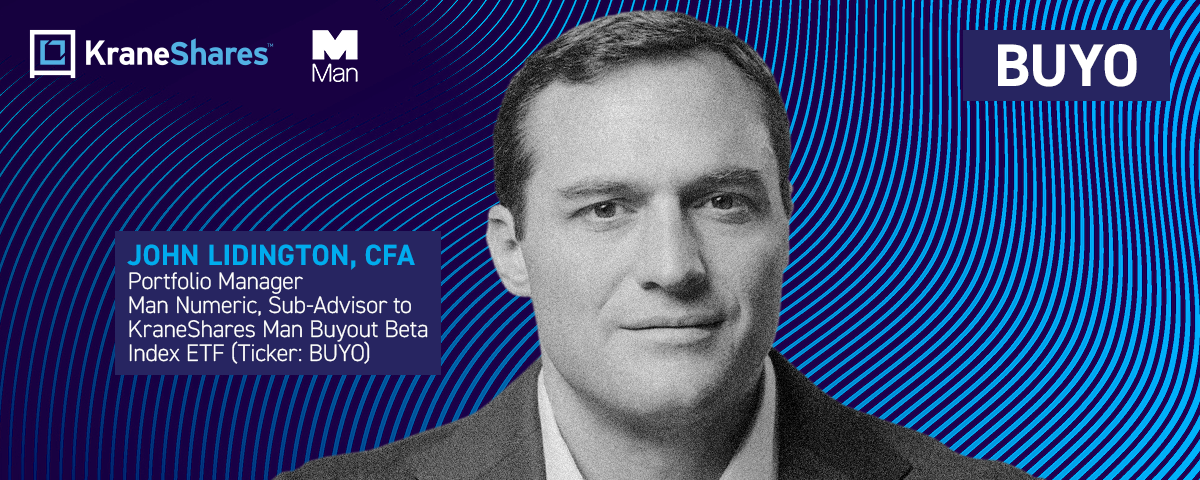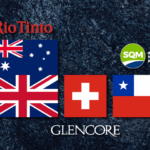
Unlock Private Equity Potential With BUYO
Portfolio Manager John Lidington of Man Numeric, Sub-advisor to the KraneShares Man Buyout Beta Index ETF (Ticker: BUYO), Tells Us How Liquid Private Equity Strategies Could Fit In Investors’ Portfolios
KraneShares:
Can you tell me a little bit about the inspiration for launching a liquid private equity (PE) strategy?
John Lidington:
The inspiration for launching our liquid PE strategy stems from a combination of strategic and tactical considerations. Initially, when we launched the strategy over six and a half years ago, it was primarily designed for our institutional clients to use within their existing PE allocations. We wanted to create a versatile instrument that could serve as an alternative to cash or other non-PE investments for investors who are ramping up their PE allocation targets or waiting for committed capital to be called but also be used tactically as a core holding in PE allocations at certain points in the PE cycle.
The evolution of this strategy was influenced by several factors in the PE landscape. In the first few years after its launch, many investors had an "if it isn’t broken, don't fix it" mentality regarding PE. However, starting around 2022, we noticed a significant shift in sentiment. We observed growing skepticism towards traditional PE, particularly due to heightened dry powder levels and committed capital not being deployed in a timely fashion, then depressed exit activity from 2022 onward.
Limited partners investing in PE funds began expressing dissatisfaction with the industry's current state. Some started questioning whether alternative approaches could help them better achieve their goals within their PE allocations. This changing sentiment provided an opportune time for us to offer our liquid PE strategy as a potential solution to address these concerns and offer a more flexible approach to PE investing.
Another key trend that has developed during the past six and a half years is the traditional PE industry’s increasing interest in the wealth market and plan to grow among individual investors. As this trend started to gain steam, KraneShares partnered with Man Numeric on the strategy and made this available in a vehicle that made it easier for these investors to access.
Impact of Economic Factors
KraneShares:
How might inflation or interest rate cycles affect the strategy?
John Lidington:
The impact of inflation and interest rate cycles on our strategy can be analyzed from two perspectives: 1) total return and 2) alpha generation, or outperformance of standard public equity indices. The total return of the Man Buyout Beta Index that we created is certainly affected by inflation and interest rate cycles, but we believe it is significantly less exposed to these fluctuations than traditional PE.
Traditional PE is heavily influenced by interest rates. At the outset of any buyout deal, the target company is typically loaded up with a significant debt burden. When that debt is more expensive, it can substantially impact the ultimate return generated from that asset. Additionally, on the exit side, higher interest rates generally lead to less exit activity, which is crucial for unlocking value and returns for limited partners.
Since the Man Buyout Beta Index is 1) comprised of companies that usually have less debt than the typical buyout company, and 2) less dependent on these exit events, it is expected to be more insulated from these interest rate effects than traditional PE.
On the alpha generation side, the Man Buyout Beta Index's potential outperformance of the broad public equity market isn't overly dependent on specific interest rates or inflation scenarios. That said, lower interest rates could potentially benefit our strategy as they could provide an impetus for traditional PE funds to deploy some of their $1 trillion-plus stockpile of dry powder1, which could increase the takeout activity of holdings in our index.
Sector Positioning
KraneShares:
Could you discuss how the strategy positions itself in certain sectors based on previous takeout deals or where buyout funds are looking?
John Lidington:
Our strategy aims to mimic the industry profile of PE deal activity closely. While we haven't seen a dramatic shift in terms of the industries in which PE has been closing its deals in recent years, we have observed some notable trends.
Over time, the strategy has increased its weight in names contained in the GICS “Software and Services” industry group, particularly Software as a Service (SaaS) companies. This reflects the growth in interest from traditional PE in this sector. We continue to see significant deal activity in industrials and healthcare as well, which remain core focus areas for PE firms.
Additionally, we're seeing deal activity in consumer discretionary and sprinkled throughout various other industries as well. Our portfolio is specifically designed to mirror this industry profile, aligning with where PE is identifying attractive targets and investing.
This alignment helps ensure that our index has comparable top-down exposures and is well-positioned to capture similar industry tailwinds as traditional PE. By closely tracking the sectors and industries where buyout funds are most active, we aim to provide our investors with exposure to the same potential growth areas and value-creation opportunities that attract PE investments and play an important role in driving traditional PE’s returns.
Performance
KraneShares:
Given that it starts with the Russell 2500 Index as the initial selection universe, can you comment on how this PE/buyout-focused index performed against the broader Russell 2500 benchmark?
John Lidington:
The performance of our strategy should be viewed in the context of what investors typically seek from PE investments. We believe the ultimate goal for anyone investing in traditional PE is to at least outperform the public equity market – otherwise, the illiquidity and higher fees associated with PE wouldn't be justified.
I'm pleased to say that our strategy has historically achieved a performance goal similar to what most PE investors are aiming for with their PE allocation, and, critically, we've done so without the long lockups and high fees typically associated with traditional PE investments. This combination of similar performance and more favorable terms for investors is a key differentiator of our strategy, forming the backbone of the investment proposition – to deliver PE-like return drivers without the PE fees or illiquidity.
Potential Allocation Scenarios for Investors
KraneShares:
Could you talk about how this strategy could potentially fit into an investor's portfolio?
John Lidington:
Our strategy offers multiple use cases for investors, each addressing different needs and market perspectives.
The first is as a tactical play. This is particularly relevant in the current market environment and environment of the past few years, which has some investors wary of the future returns of recent and current vintages for traditional PE due to elevated purchase price multiples and higher interest rates. For those who still believe in the underlying thesis of PE outperformance but are concerned about the current environment, our strategy provides exposure to similar return drivers without the long-term commitments and vintage risk of traditional PE.
The second use case, which was our original design intent, is as a strategic tool within an existing PE portfolio. It can serve as an alternative to holding cash or other non-PE investments for investors who are ramping up their PE allocation targets or waiting for committed capital to be called. Since making PE allocations and investments often takes considerable time, our strategy offers a way to park capital in a PE-like investment while waiting for PE investments to be made.
Over time, our thinking has evolved to view this strategy as a potential core holding within a PE allocation. Much like how some investors may use passive vehicles to harvest the equity risk premium in public markets, our strategy can be seen as a way to harvest what we call the “private equity risk premium” more cost-efficiently. This approach allows for a core-satellite strategy within one’s PE allocation, where investors can get broad, diversified* exposure to key PE return drivers through our cost-efficient core and then allocate to niche, high-conviction PE managers as satellites.
This core-satellite approach mimics what you see in other long-only asset classes that have an easily investable beta (including diversified, actively managed strategies that are beta-1) to capture the returns of the asset class broadly, whether it be listed equity, fixed income, or real estate with REITs. Our strategy essentially provides a low-cost** core for PE that didn't really exist before, offering investors a new way to structure their PE allocations more efficiently and flexibly.
Conclusion
It was a pleasure speaking with John and gaining his valuable perspective on how BUYO may reshape investors’ understanding of traditional PE. John’s insights highlight the versatility and potential of this approach, addressing both tactical and strategic needs in investors' portfolios while providing PE-like returns without the typical drawbacks like high fees and long lock-up periods.
For BUYO standard performance, top 10 holdings, risks, and other fund information, please click here.
*Diversification does not ensure a profit or guarantee against a loss.
**Buying and selling shares of the BUYO ETF can result in brokerage commissions.
Citations:
Data from Statista as of March 2024. Retrieved 12/31/2024.


















